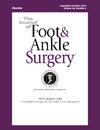踝关节骨折手术治疗后恢复运动的预测因素。
IF 1.3
4区 医学
Q2 Medicine
引用次数: 0
摘要
实现恢复运动(RTS)是处理运动员踝关节骨折的关键。本研究旨在确定踝关节骨折手术固定后恢复运动的因素。研究对 2020 年 1 月至 2021 年 1 月期间接受手术治疗的 93 名移位或不稳定踝关节骨折的现役患者进行了回顾性分析。中位随访时间为 2.12 年。对临床、功能和影像学方面进行了评估。其中,82.8%的运动员在手术后恢复了运动,26.9%的运动员在3个月内恢复了运动,75.3%的运动员在1年后恢复了运动。1年后,40.9%的运动员恢复了受伤前的活动水平。RTS与AO/OTA骨折亚型之间存在明显关联(p = 0.038)。非极板骨折的疗效最好,100%的患者在中位数4个月内实现了RTS。双极骨折有80.77%在6个月内达到RTS,三极骨折有65.22%在8个月内达到RTS。AO/OTA亚型B和C预示着RTS较低,无法恢复到受伤前的水平,双极和三极骨折的恢复时间也较晚。这些发现强调了骨折严重程度对RTS的影响,骨折越复杂,恢复效果越差,恢复时间越晚。证据等级:证据等级:III。本文章由计算机程序翻译,如有差异,请以英文原文为准。
Predictive factors to return to sport after surgical management of ankle fractures
Achieving Return to Sport (RTS) is crucial in managing ankle fractures for athletes. This study aimed to identify RTS factors post-surgical fixation of ankle fractures. A retrospective analysis was conducted on 93 active patients with surgically treated displaced or unstable ankle fractures from January 2020 to January 2021. The median follow-up was 2.12 years. Clinical, functional, and radiographic aspects were evaluated. Among the athletes, 82.8 % resumed sports post-surgery, with 26.9 % returning within 3 months and 75.3 % at 1 year. At 1 year, 40.9 % regained their pre-injury activity level. There was a significant association between RTS and AO/OTA fracture subtype (p = 0.038). Unimalleolar fractures had the best outcomes, with 100 % achieving RTS in a median of 4 months. Bimalleolar fractures had 80.77 % RTS in 6 months, and trimalleolar fractures had 65.22 % RTS in 8 months. AO/OTA subtypes B and C predicted lower RTS to pre-injury levels, with delayed recovery for bimalleolar and trimalleolar fractures. These findings underscore the impact of fracture severity on RTS, with more complex fractures leading to poorer and delayed recovery outcomes.
求助全文
通过发布文献求助,成功后即可免费获取论文全文。
去求助
来源期刊

Journal of Foot & Ankle Surgery
ORTHOPEDICS-SURGERY
CiteScore
2.30
自引率
7.70%
发文量
234
审稿时长
29.8 weeks
期刊介绍:
The Journal of Foot & Ankle Surgery is the leading source for original, clinically-focused articles on the surgical and medical management of the foot and ankle. Each bi-monthly, peer-reviewed issue addresses relevant topics to the profession, such as: adult reconstruction of the forefoot; adult reconstruction of the hindfoot and ankle; diabetes; medicine/rheumatology; pediatrics; research; sports medicine; trauma; and tumors.
 求助内容:
求助内容: 应助结果提醒方式:
应助结果提醒方式:


